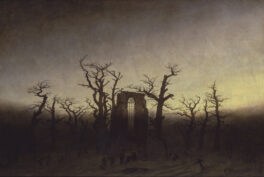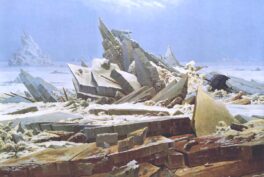It is well understood that the art world is a community where artists rely on and inspire each other. We, who appreciate artists and their works, learn over time to examine and appreciate every piece and the authors who made them in their separate, but for the most part, equal, respective lenses.
But there must remain a place in our tender judgment of art for recognizing artists who seem to speak with a tongue so unlike what we’ve heard before, yet immediately familiar to the deepest senses of our mind and spirit, as if uttered from our innermost honest self. These are those who crash into our lives beyond galleries and museums like waves breaking against rocks while other artists remain a ripple.
Caspar David Friedrich is, in my book, the preeminent artist of the entire movement of Romanticism. His works alone can justify its existence and significance. I and others hold his work in such high regard because through his works, especially in Wanderer above the Sea of Fog, we are acutely educated in what exactly Romanticism (and much of art in general) is about—our inner world being communicated through existence in our outer world.
Wanderer above the Sea of Fog
The sea of fog spans the blue, foreboding valley, jagged cliffs tear apart the mist, and the unapproachable large mountains and peaks loom in the distance. A solitary man stands perched on the rocks, looking over the expanse. The wind whips in his hair and jacket, his staff supports him, his foot is placed forward, his next step is careful, and his journey into the mist is inevitable. The morning light tinges the world with gold, whispering optimism as the sun rises with the man. The terrain ahead is unwelcoming, and the man is unyielding.
Aloft and Alone—The Composition
The composition of this painting is very familiar to another one of Friedrich’s, Woman at a Window. Both paintings feature a person with their back to the viewer, looking out at the world, who is centered on the canvas as the main focal point. The ridges of the distant mountains are used as leading lines to point our attention to the man at the center as if the vista is springing forth from him. This is unlike other paintings by Friedrich that feature people out in the elements of nature such as his painting Man and Woman Contemplating the Moon, where the people are on the left third of the painting.
In Woman at a Window, the woman fills us with the excitement of discovery in the world outside of the window. In Wanderer above the Sea of Fog, the man, looking down from the height, fills us with apprehension and uneasiness about the world ahead of us. He also makes us reflect and ponder about ourselves. As the clearly stated subject in the painting, he peers out into the world as we peer into him as if he were the window. What we may find is suggested to us by the weary and mysterious world ahead of him.
Frost of Solitude—The Color
What stands out the clearest is the frosty blue and white colors of the overcast sky and fog. They literally engulf the dark browns of the land. This lends heavily to the uneasy emotion felt looking over the land. While the color of the fog is smothering the canvas, if we look close enough, we see the feathering of gold bobbing on the waves of fog as a light, careless bird would on the ocean.
Gold is the color of optimism and inspiration and can be overpowering. Its gentle touches are enough to reassure us that there is great promise for those who venture into the unknown while not distracting from the beautifully heavy mood. We also see the gold used to crown the man in thick blonde hair that straps in the wind.
What Do I Seek?—The Man
Caspar David Friedrich is well known for the landscapes he painted. He was frequently pondering the lush area he was raised in and knew by heart—the island of Rügen in Germany as told to us by physician Gotthilf Heinrich von Schubert. To Romantics, nature is filled with raw and unpredictable glory. By viewing it, the rawness and unpredictability of our humanity are made manifest.
Using nature, Friedrich tells the story of us, written in newly sprouted greenery, wisping wind, and crumbling stone. We are inseparably connected to nature in his paintings—like a child existing in his mother’s womb—we are within our world and our world within us. This oneness between us and nature is a source of inspiration for the movement. I believe this knowledge is the key to understanding the art of Caspar David Friedrich. In Wanderer above the Sea of Fog, a man confronts an unknown land—he confronts himself.
I am just scratching the surface and hopefully introducing some new art admirers to Caspar David Friedrich. He is a master of infusing philosophy in art and expressing complex emotions.











